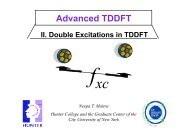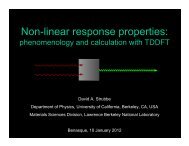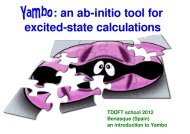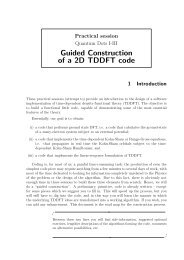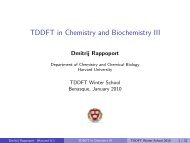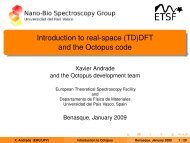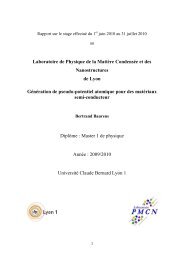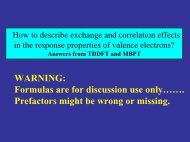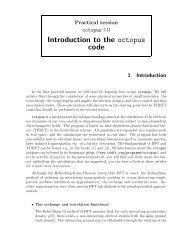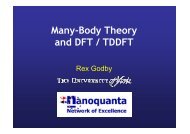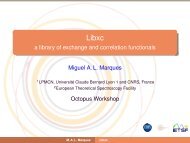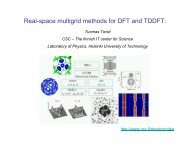Overview of spectroscopies I (MC) - TDDFT.org
Overview of spectroscopies I (MC) - TDDFT.org
Overview of spectroscopies I (MC) - TDDFT.org
You also want an ePaper? Increase the reach of your titles
YUMPU automatically turns print PDFs into web optimized ePapers that Google loves.
Manuel Cardona, Max-Planck- Institut für FestkörperforschungStuttgart, GermanyIn honor <strong>of</strong> Max Planck‘s 150 th birthday (b. April 23, 1858, † Oct. 1947)Lectures 1 and 21979Dr. Rer.Nat.Dielectric function <strong>of</strong> semiconductorsDependence <strong>of</strong> electronic structure 1901onEinstein lookTemperature, including zero-point vibrations1930(isotope effects)193019301910 Einstein look1979Dr. Rer. NatBernasque, Sept.2008~1946, withwife Marga1
GermaniumPseudopotential band structure <strong>of</strong>gerrmanium including spin-orbitinteraction (0.2 eV for EDielectric function <strong>of</strong> germanium1, E 1+ Δ 1)obtained from reflectivity spectrum Fundamentals <strong>of</strong> Semiconductors,by Kramers-Kronig analysis, at 300K Yu+CardonaPhilipp and Taft Phys Rev 113 1001 (1959)E 1transitions should be spin-orbit split butNot enough resolutionExperimental discovery<strong>of</strong> spin-orbit splitting <strong>of</strong>E 1gapTauc and AntončikPRL 5 253 1960Spin-orbit splittings have played a very important role in the interpretation <strong>of</strong> themeasured optical spectra in the visible and eV. Most state <strong>of</strong> the art codesto perform such calculations do not include it. They also assume that the atomsare at fixed lattice positions and neglect thermal vibrations, including zero-pointqm vibrational effects.2
Benedict, Shirley, Bohn, PRB 57, R9385 (1998): Electron-hole quasiparticals plusdirect (screened) and exchange (unscreened) exciton interactionSolid line:Measured,Unfortunately 300KCalculation lower thanExper. because noexciton interactionE 1 E 2Calculations:No temperature,No zero-point vibrationsNo spin-orbit couplingE 1E 2E 1,E 1+Δ 1E 23
Shift 0.2eVIn part 300K E 1siliconDiamond, ellipsometry 300KEllipsometryAspnes+Studna300KExp. at 300 KHahn, Seino, Schmidt, FurtmüllerBechstedt, p.stat. sol.(b) 242 2720 (2005)R.Ramírez et al.,Phys Rev B77,045210(2008); Path Integral Molecular Dynamicscalculation1.5 eVThe lowest direct gap <strong>of</strong> diamondIs lowered by 0.7 eV by e-p interact.(right). The shift in the lower flank <strong>of</strong>Im ε (ω) may be due, in part to e-pZero point0.7 eVDiamond4
Albrecht et al. PRL 80.4510(1998)Cardona, Lastras et al. PRL 83.3970(1999)Albrecht et al.PRL80,4150(1998)Cardona et al.PRL83,3970(1999)State <strong>of</strong> the art calculation, no phononsZero point?90meVNo excitonsEllipsometry at 300KEllipsometry at 20K, Lautenschlageret al. PRB 36.4821(1987)5
The electronic properties <strong>of</strong> crystals are affected by the lattice vibrations throughelectron-phonon interaction. These effects depend strongly on the temperature Tbut do not disappear even at T=0 because <strong>of</strong> the zero-point vibrations. The T=0effects are quantum effects which decrease with increasing isotopic massBelow is shown as an example the temperature dependence <strong>of</strong> the spectra <strong>of</strong> theimaginary part ot the dielectric function <strong>of</strong> Gallium Arsenide for several T ‘s,Measured by ellipsometry.P.Lautenschlager et al., PRB 35, 9174 (1987)Photon Energy6
Comparison <strong>of</strong> calculated with measured imaginary part <strong>of</strong> dielectric function<strong>of</strong> Gallium Arsenide. Calculations performed by averaging 2 for various staticphonon displacements „frozen phonons“ whose amplitude depends ontemperature. Lots <strong>of</strong> computation. No SO splitting, zero-point „by hand“See Ibrahim, Shkrebtii et al, PRB 77, 125218 (2008), theory and experiment.Probably first such calculation! Phonon displacements determined bymolecular dynamics. Use supercells.It is possible to calculate the shift with temperature and zero-point vibs. <strong>of</strong> specificcritical point energies. This will be discussed next7
Recent work by A. Marini, PRL in press (2008)ab initio calculation <strong>of</strong> imaginary part <strong>of</strong> dielectricfunction <strong>of</strong> silicon including electron-phononinteraction and effects <strong>of</strong> this interaction onexciton effects. Blue curves are experimental data<strong>of</strong> Lautenschlager et al., PRB 36, 4821 (1897)8
Three electron-phonon interaction terms must be consideredto lowest order in T :1. Thermal expansion: can be included as a change <strong>of</strong> the lattice constants with Tor with isotopic mass at T=0 : Quasistatic approximation (somewhat trivial) dEE ln VdlnV ln V q [2 ( ) 1], jq , jnB q , jBV2. First and second order electron phonon interaction: renormalization <strong>of</strong>electron propagators:Fan termsAntončik termsu u u 2 uq,j {2[exp( / kT) 1] 1}4M2 1 fM;4MM4 f1212 Complications at low T discussed laterZero pointAt high T, kT , independent <strong>of</strong> M (classical effect)At low T, M -½ , zero point vibrations (quantum)9
Information on electron-phonon effects can be obtained eitherfrom the temperature dependence or from isotope effects at T=0Natural Abundance <strong>of</strong> some Stable IsotopesCarbon12 C 99%; 13 C 1%; 14 C unstable (dating) ; Nitrogen 14 N 99.6% ; 15 N 0.4%Silicon28 Si 92%; 29 Si 5%; 30 Si 3%Germanium 70 Ge 22%; 72 Ge 28%; 73 Ge 8%, has nuclear magnetic moment I = 9/2; 74 Ge 35%; 76 Ge6%Tin (gray)112 Sn 1%; 114 Sn 0.6%; 115 Sn 0.4%;116 Sn 14.3%; 117 Sn 7.6%; 118 Sn 24.2%119 Sn 24.2%; 120 Sn 32.6%; 122 Sn 4.7%; 124 Sn 5.8%CopperChlorineZincSulfur63 Cu 69.2%; 65 Cu 30.8% nuclear magnetic moment35 Cl 75.8%; 37 Cl 24.2% “ “ “64 Zn 48.6%; 66 Zn 27.9%; 67 Zn 4.1%; 68 Zn 18.8%32 S 95.2%; 33 S 0.75%; 34 S 4.21%; 36 S 0.02%10
A single crystal <strong>of</strong> 29 Si (5% natural isotopic abundance) grown byVITCON (Germany, Dr.Pohl) from 29 Si separated in Russia byEFFECTRON (Moscow, Zelenogorsk)Because <strong>of</strong> its nuclear spin, 29 Si has been suggested for the realization<strong>of</strong> quantum bits [T.D. Ladd et al., PRL 89, 017901 (2002)]1 cm11
CdS Phonon dispersion relations:In. Neutron ScatteringA.Debernardi et al. Solid State Comm. 103, 297(1997)Natural Cd has 113 Cd,the strongest neutronabsorber. Hence, till thiswork no dispersion relations<strong>of</strong> CdS, the canonicalwurtzite-type materialavailable. These INS measurementswere performedwith 114 CdS which does not absorb neutrons.13
2.9meVParks et al. PRB49,14244(1994)Renormalization <strong>of</strong> the direct gap <strong>of</strong> Geby electron-phonon interaction0.95Linear extrapolationE 0= 60meVThe renormalization E 0can be determined either by thelinear extrapolation <strong>of</strong> E 0(T) or from the dependence <strong>of</strong>the gap on isotopic mass which is proportional to M -1/2The extrapolation gives 60meVThe isotope shift 2.9x2x(73/6)=70meVThe most recent semi-ab-initio calculation[Olguin et al.SSC 122 575 (2002)]gives 64meVCan be fitted withsingle oscillator:Einstein modelThis renormalization should be taken into account whenstate <strong>of</strong> the art ab initio calculations <strong>of</strong> the gap are comparedwith experimental results.ΔE(T)= ΔE o [ 1+2(1-exp(ω E /kT) -1 ]14
Dependence <strong>of</strong> the indirect gap <strong>of</strong> diamond on temperature and isotopic massFit <strong>of</strong> E ind(T) with a single Bose-EinsteinLinearextrapolationterm <strong>of</strong> average frequency1080 cm -1 . The Ramanfrequency <strong>of</strong> diamond is1300 cm -1 . = 370meVΔ(M) = AM -1/2 = 370 meVΔ(M 13 )- Δ(M 12 )=-(1/2)AM -3/2 =-(1/2)• Δ(M)•M= 14.8 meVIsotope shift=15meV12CThe T=0 renormalization calculated from the isotope shift usingthe M -1/2 law is = 15meVx2x(12/1)=360meV,VERY LARGE! (= 60meV for Ge, 65 meV for Si )13CElectron-phonon interaction calculations byZollner et al.[ PRB 45, 3376 (1992)] usingsemiempirical pseudopotentials givean even larger value: = 600meV!!! STRONGELECTRON-PHONON INTERACTION:SUPERCONDUCTIVITY?A.T.Collins et al., PRL 65,891(1990)Computational band structure theorist beware!!Tiago, Ismail-Beigi, Louie PRB 69 125212 (2004) 15Si, Ge and GaAs, GW approximation, no e-p interact.
7.37.27.4ΔE = 0.7 eVClassical molecular dynamicsLowest direct gap<strong>of</strong> diamond (E ‘ o) ,Γ 25‘ Γ 157.1Measured,Logothetidis et al.PRB 46, 4483 (1992)1000Ramírez et al.PRB 73,2452022006Squares ,Quantum (path integral)MD calculations.For diamond the volume effectis negligible:0.03eV at T=0compared with 0.7 eV total16
Because <strong>of</strong> strong electron-phonon interaction, superconductivitypossibleSuperconductivity in boron-doped (~2x10 21 cm -3 )diamond films produced by CVDMore recent T c =11.4 KY. Takano et al.Diamond and rel.mat.16, 911 (2007)Y.Takano et al., APL 85, 2851 (2004);Ekimov E.A. et al. Nature 424, 542(2004)17
Although no isotope effect measurements available,all seems to indicate that we are dealing with BCS-type superconductivity. Scanning tunneling microscopyhas yielded a gap Δ=0.87 meV for T=0.47K,Hence 2Δ /kT c = 3.7 (BCS).The points are experimentalFor B-doped diamond, the solidlines are guides to the eye, Thedashed line a fit with McMillan‘sequation.From M.Cardona, Sci. Tech. <strong>of</strong> advancedmats. 7, S60 (2006)Exp. Points: J. Kačmarčik et al.,Phys. Stat. Sol.(a) 202,2160 (2005)H. Mukuda et al., PRB 75, 033301 (2007)18
Estimate <strong>of</strong> the critical temperature T cAlthough no measurements <strong>of</strong> isotope effect on T c available yet,because <strong>of</strong> strong electron-phonon interaction we conjecture that thesuperconductivity mechanism is BCS-like, Cooper pairs glued byphonons.●McMillan equation:●1 12 2TcTDexp{ [ (1 ) *] ; =NdD / MDWhere is the hole-phonon coupling constant and * represents thehole-hole Coulomb repulsion. N d is the density <strong>of</strong> hole at the FermiLevel, T d and d the “Debye” temperature and frequency, resp. and Dan average hole-phonon deformation potential. Taking standard values<strong>of</strong> these parameters from the literature and assuming * 0we obtained (M.Cardona,Solid State Com. 133,(2005),3) T c 5.2 K.For hole concentration N h = 2.2x10 21 cm -3 . .19
Fermi Surface <strong>of</strong> diamond and electron-phonon processes relevant forDSUPERCONDUCTIVITY●2e-pDe-pHeavyholesN DMd ; 1/2 =(0.55d 0 /a 0 )eV /Ǻ0Diamond : d 0= 85eV; Silicon d 0= 35eVSpin split holesLight holes85 2 370meV( ) 5.9; ( ) 6.135 60meVGap RenormalizationsWith these values <strong>of</strong> d 0one obtains T c=5.2K for diamond with 2x10 21 holes/cm 31.2% Boron; Basically T c≈ 0 for silicon (for μ* = 0) Cardona SSC 133 (2005) 3.Boeri et al. PRL 93,237002(2004): T c= 0.2K (for μ* = 0.1) for 3% BLee and Pickett PRL 92, 237003(2004): T c= 7K (for μ* = 0.15) for 2.5% BXiang et al., cond:mat/0406446 v3 T c= 4.4 K (for μ* = 0.15) for 2.8% B20
Recent calculations:Giustino, Yates, Souza,Cohen, Louie U.C. BerkeleyPRL 98, 047005 (2007)Use millions <strong>of</strong> points in k-space and either C-B virtual crystalor a supercell with boron in the center. Include boron vibrationsFind for N h ~ 2x10 21 cm -3 T c = 4K21
Why is the electron-phonon interaction so muchstronger in diamond than in germanium or silicon?The large e-p interaction with the top <strong>of</strong> the valence bandseems to be a property <strong>of</strong> the elements <strong>of</strong> the second row <strong>of</strong>the periodic table ( carbon, nitrogen, oxygen…). We shall seenext that that the e-p interaction, as obtained from thedependence <strong>of</strong> the gap on T and on M, is also large in GaN ain ZnO and, as will be seen later, in SiC.Handwaving argument:C, N, O.. have no p-electrons in the core and the p valence electrons, as the atomsvibrate, can get much closer to the core than in cases where p-electronsare present in the core: germanium, silicon, GaAs….22
Another possible heuristic explanation is that for materialswith atoms <strong>of</strong> the second row the gaps are large. In pert.theory intraband and interband terms contribute to theself-energy. Usually (Ge, Si) they compensate each other.For large gaps intraband terms increase, interband onesdecrease and the sum can become larger.IntrabandInterbandThe two heuristic explanations may beequivalent in some way !interband23
2.9meVParks et al. PRB49,14244(1994)Renormalization <strong>of</strong> the direct gap <strong>of</strong> Geby electron-phonon interaction0.95Linear extrapolationE 0= 60meVThe renormalization E 0can be determined either by thelinear extrapolation <strong>of</strong> E 0(T) or from the dependence <strong>of</strong>the gap on isotopic mass which is proportional to M -1/2The extrapolation gives 60meVThe isotope shift 2.9x2x(73/6)=70meVThe most recent semi-ab-initio calculation[Olguin et al.SSC 122 575 (2002)]gives 64meVCan be fitted withsingle oscillator:Einstein modelThis renormalization should be taken into account whenstate <strong>of</strong> the art ab initio calculations <strong>of</strong> the gap are comparedwith experimental results.ΔE(T)= ΔE o [ 1+2(1-exp(ω E /kT) -1 ]24
Temp. Dep. <strong>of</strong> gap: SiC, path integral molecular dynamicsTotalRenorm.Si contrib.Carbon contributionHernández, Herrero, Ramírez, Cardona, PRB 200825
Superconductivity in boron-doped siliconE. Bustarret et al., Nature 444,465 (2006)1. (5x10 21 holes/cm 3 )2. (2.8x10 21 „)26
Recent paper: B-doped SiC, Zhi-an Ren, J.Akimitsu et al., J.Phys Soc.Japan 76, 103710 (2007)27
Specific heat <strong>of</strong> diamond vs.T: Einstein, Nernst-Lindemann, DebyeNernst-LindemannZ.Elektrochemie 817 (1911) experimental dataDebye, T D =1830 KAnn. Phys. 39,789 (1912)Einstein, T E =1450 Kaccording to DebyeEinstein, T E =1300 KAnn.Phys. 22, 180 (1907)So far we used fits with 1 Einstein oscillator, Sometimes two Einstein oscillators betterFrequency,ThzNernst-LindemannReduced wavevector28
Walter NernstF.A. Lindemann,Viscount Cherwell29
Luis Viňa (Stuttgart, 1981)Patrici Molinàs (Stuttgart, 1990)Javier Tejeda (Stuttgart,1976);Gerardo Contreras (Stuttgart,1986)J<strong>org</strong>e Serrano (Stuttgart, 2003)Manuel Cardona (Harvard, 1959)William Paul (Aberdeen, 1951)R.V. Jones (Oxford, 1934)F.A. Lindemann (Berlin, 1911)W.H. Nernst (Wurzburg, 1887)Friedrich Kohlrausch (Gottingen, 1863)Wilhelm Weber (Halle, 1826)Johann Schweigger (Erlangen, 1800)Ge<strong>org</strong> Hildebrandt (MD, Gottingen, 1783)Johann Gmelin (MD, Tubingen, 1769)Philipp Gmelin (MD, Tubingen, 1742)Burchard Mauchart (Lic. Med., Tubingen, 1722)Elias Camerarius Jr., (MD, Tubingen, 1691)Elias Camerarius Sr., (MD, Tubingen, 1663)Those Germans sure know how to keep records!30
Temperature and isotope effects in binary compounds: GaNThe zero-point vibrations <strong>of</strong> different atoms contribute differently to T=0 renormalizations:Different atoms show different isotope effects, especially if their M’s are very different:GaNSo far we have used single oscillator B-E fits (Einstein model <strong>of</strong> C v ). For binarieswith very different M’s two oscillators are needed (Nernst-Lindemann C v ).The Debye model may be necessary at very low temperatures, as it is for C vdEET ( ) E0 2 MGa [2 nB ( Ga/ kT) 1]dMGadE2 MN[2 nB( N/ kT) 1]dMNThe temperature shift gives directly the sum<strong>of</strong> anion and cation contributions. The isotopeeffects are more informative since they givethe separate contributionsManjon et al.Europ.phys.j. B40,4553(2004)170meVGaNdE/dM N =4.2meVdE/dM Ga =0.4meVFor diamonddE/dM C =7meV/atom!,why C and Nso large? No p-electrons in core? N =790cm -1 Ga =350cm -131
Contribution <strong>of</strong> zinc and oxygen to the zero-point renormalization <strong>of</strong> the ZnO gapExcitonic band gap vs. M zn+ M o(M Zn+M o) (amu)Oxygen 135 meVZinc 29meVFor GaN it is:Gallium 56 meV, nitrogen 203 meVFor diamond it is 360meV= 180 +180 meVRB Capaz… and SG Louie PRB 94, 036801 (2005) use twooscillators to fit T-dependence <strong>of</strong> gaps <strong>of</strong> nanotubes32
Anion and cation contributions to the zero-point renormalization andthe temperature dependence <strong>of</strong> gaps can be very different. For CuCl,CuBr, and CuI they even have opposite signs! Unusual effects appear.A.Göbel, PRB 57, 15183 (1998)65CuCl65CuCl63CuCldE 0/dM Cu= -0.076meV/amuBranchCu-likeCu 35 ClCu 37 CldE 0/dM Cl=+0.036meV/amubranchCl-likeThe isotope data have been crucial for understanding 33the strange behavior <strong>of</strong> E 0(T) in copper halides. CuGaS 2 ?
Periodic Table ( Section)Mg Al Si P S ClCu Zn Ga Ge As Se Br (3d-core electrons)Ag Cd In Sn Sb Te I (4d-core electrons)Core d-electrons-10 eV-20 eV-30 eV-40 eV-50 eVCu and Ag d-core electrons hybridize withvalence p-electrons34
Low temperature behavior <strong>of</strong> E 0 (T): Debye ModelThe average energy <strong>of</strong> the phonons is:.Since < u 2 > (M ) -1/2 we find for the gap renormalization at T0:0Cep1[ n( / kT) ] Nd( )d2This equation differs from that above by a factor <strong>of</strong> -2 in the integrand. However:C e-p must vanish for T 0 ( 0 phonons are a uniform translation) and C e-pmust be proportional to 2 . Hence in the low T limit behaves like T 435
Sharp indirect edge luminescence in isotopically pure SiThe T 4 dependence <strong>of</strong> the gap <strong>of</strong> a semiconductor at low T( T
Very high resolution(< 0.2 eV) excitation spectroscopy measurementswere performed last year by M.Thewalt et al. on pure 28 Si. Theyconfirmed, for the first time, the T 4 dependence <strong>of</strong> the gap shift.(F in GHz)T 40.15GHz=0.6eV0.08GHz=0.3eV( T in Kelvin)Cardona,Meier,Thewalt,PRL 92,196403(2004)3729
DIAMONDT. Sato et al. PRB 65, 092102 (2002)300 KT 4 (10 9 K 4 )For diamond the average γ isNearly temperature independentV n A Tln q, jq, j[2 B( q,j) 1] 0.017BV q,j4If constant move out <strong>of</strong> the sumthe sum is then proportional to T 4 plus zero point effect38
Ultrahigh resolution <strong>of</strong> photoluminescence excitation spectrum <strong>of</strong> excitons bound to neutralphosphorus in isotopically pure Si (99.991% 28 Si). Width <strong>of</strong> exciting laser: 0.3neV. Observedwidths: 150neV(inhomogeneous still, should be ~ 5 neV).These lines are split by half thehyperfine splitting = 486/2 = 243neVExciton boundto neutralPNeutral donorM.L.W. Thewalt et al. JAP 101 081724 (2007)39
90 meV, confirmed by isotope measurements, 28 Si vs. 30 SiP. Lautenschlager et al., P.R B31, 2163 (1985)L.F. Lastras Martínez et al. PRB 6112946 (2000)E 1, E 1+ Δ 1(eV)GermaniumRönnow, Lastras et al. Eur. Phys. J.5, 29 (1998)Germanium40
CONCLUSIONS1. State <strong>of</strong> the art calculations <strong>of</strong> dielectric function <strong>of</strong>semiconductors is in good shape but does not includeelectron-phonon interaction (Temperature dependence)nor spin-orbit coupling2. Measurements <strong>of</strong> dependence on temperature andisotopic mass are beginning to be compared withstate <strong>of</strong> the art ab initio calculations3. Particularly interesting are the isotope effects in binaryor multi-nary materials ( ZnO, CuGaSe 2 )4. Dependence on mass at T~ 0 is strong for atoms <strong>of</strong> thesecond row <strong>of</strong> the Periodic Table ( C, N, O ). It seems relatedto the appearance <strong>of</strong> supercunductivity in B-doped diamond5. Superconductivity has been seen in heavy B-doped Si, SiCIt should be observable in heavy p-type GaN, ZnO…p-type InN:R.E.Jones,E.E. Haller et al., PRL 96,12505 (2006) ?6. Ultra- sharp edge emission spectra for isotopically pure materials:hyperfine splittings41



